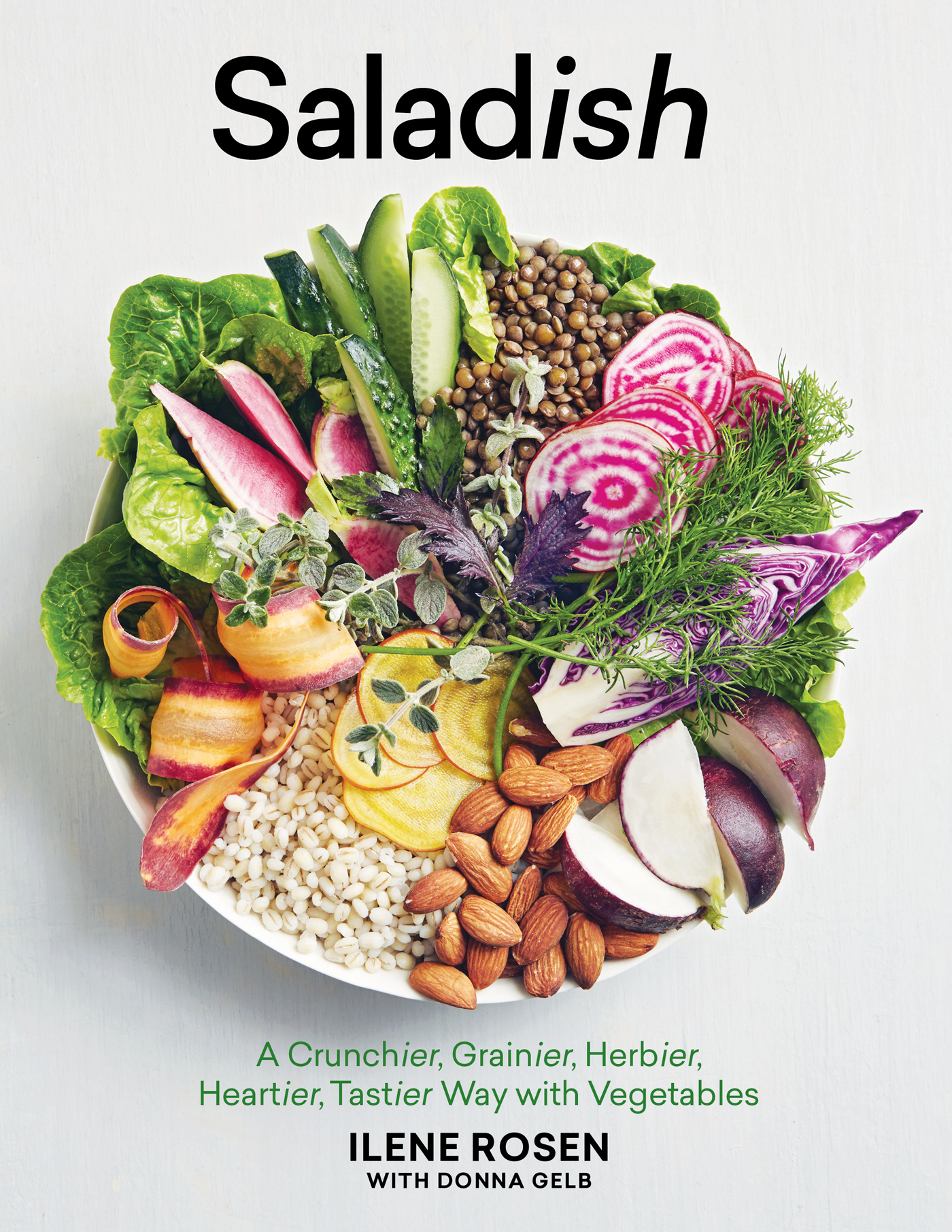 Saladish A Crunchier, Grainier, Herbier, Heartier, Tastier Way with Vegetables Ilene Rosen with Donna Gelb Photographs by Joseph De Leo illustrations by emma dibben
Saladish A Crunchier, Grainier, Herbier, Heartier, Tastier Way with Vegetables Ilene Rosen with Donna Gelb Photographs by Joseph De Leo illustrations by emma dibben  Artisan | New York For my mother, and for the memory of my father. For Isabel and for Hannah. Contents Introduction All the food I really love to make and eat is saladish. The base might be leafy greens or nutty farro. The salad may be fluffy or crisp, spicy or sweet, tangy or creamysome of my favorites are a combination of all these (and more!). Healthy, satisfying, and simple to prepare, salads can be made from anything and everythingand a salad makes a meal.
Artisan | New York For my mother, and for the memory of my father. For Isabel and for Hannah. Contents Introduction All the food I really love to make and eat is saladish. The base might be leafy greens or nutty farro. The salad may be fluffy or crisp, spicy or sweet, tangy or creamysome of my favorites are a combination of all these (and more!). Healthy, satisfying, and simple to prepare, salads can be made from anything and everythingand a salad makes a meal.
Two salads are even better. Three or more is a party! Ive always been a champion eater. My first foray into cooking was at age nine, when my friends and I would attempt to outweird each other with concoctions that I, nonetheless, found delicious. What began as after-school entertainment developed into a fearlessness when it came to experimenting with flavors, and a willingness to step outside the boundaries of what people typically think go togethertraits that have served me well in my adulthood. (No doubt the owes its parentage to my middle-school cravings.) In my thirties, a passion for produce and cooking seasonallysparked by the mind-blowing bounty of the nearby Union Square Greenmarket in New York Citycompelled me to move my interior design career to the back burner and enroll in culinary school. Diploma in hand, I knocked on the door of the only place I wanted to work: the City Bakery.
My favorite neighborhood spot, its stark interior was the backdrop for simple, unembellished pastries that resonated with my designers love of minimalism, color, and form. This was a special place, like none Id ever seen before. I asked for a job and stayed for fifteen years. It was an amazing opportunity. I was given free rein in the kitchen, expanding the menu of savory dishes and purchasing everything I could from the nearby greenmarket. And the bakery grew along with me; in its tenth year, we moved to a much larger location.
The delicious pastries took center stage on the dark stone counters up front while my territory grew to forty linear feet of salad bar: counters arrayed with self-service-style platters and bowls that brimmed with an ever-changing selection of lunch items. Everything could be made ahead and left to sit in the fridge, and it would still be delicious. It was a practical style of cooking and eating that stuck with me and became my MO as I raised my twin daughters. The recipes were adapted over time, and my favorites appear in this bookmade all the more accessible by the ever-increasing availability of fresh, seasonal ingredients in farmers markets and supermarkets nationwide. I was living in lower Manhattan during this time, and I regularly explored Chinatowns overflowing markets, buying a few new-to-me items on each trip. There were so many exciting discoveriesfrom bushels of bunched greens to heaps of gnarly vegetables, plus mysterious condiments and products with incomprehensible (to me) labelsit made my head spin.
I was also in striking distance of the strip of international grocers on Lexington Avenue around 28th Street known as Curry Hill for its wealth of aromatic Indian and Middle Eastern ingredients. Combining these far-flung flavors in salads of seasonal produce and hearty grains and beans became a signature of my casual, unconventional style. I tossed Chinese black rice with fresh pea greens, and flavored them with a makrut lime dressing (see ). To my surprise and delight, the salad bar at City Bakery developed a cult following, with a huge crowd eager to share in all the vegetable goodness each day. In 2013, along with kindred spirit Sara Dima, I opened R&D Foods, a specialty food shop in Brooklyn, New York. Its a tiny place with lots of ideas and a big sense of community.
Every morning I make cake doughnuts, and all day long my team and I turn out brined roast chickens, sandwiches to order, and ever-rotating bowls full of saladish creations, many of which youll find in the pages of this book. I hope youll enjoy these dishes, that theyll encourage you to rethink your pantry and broaden your repertoire. Although the recipes are arranged seasonally, many span several seasons, and some can be made all year long. Dont be afraid to substitute one green or grain for another, and please dont stop there! Use these recipes as a point of departure for your own creative journeys. Hang out at your local farmers market, poke around an ethnic grocery, grab an unfamiliar ingredient, and make something saladish! The Salad ish Manifesto Whether composing a basic leafy salad or something more complex, my guidelines come down to the following. Start with the Best Get the highest-quality ingredients you can find, and the freshest produce at the height of its season when possible.
If you choose your ingredients carefully, you can let each one shine. Play with Contrasting Textures... For a salad that grabs your attention at first bite and draws you in, include at least one component from several of the following categories. Toothsome: Roasted vegetables, grains Fluffy: Tender lettuces, herbs, soft leaves Crunchy: Sturdy greens and their stems, nuts and seeds Crisp: Sliced or diced raw vegetables, pickled things Hefty: Potatoes, bread cubes, meat, fish, tofu, cheese ...and Contrasting Flavors The best salads have components that work well together yet sing out individually. Compose your dish with some (or all!) of these elements. Richness: This can come from the oil in your dressing, from roasted vegetables, from cheese, and/or from nuts and seeds.
Sharpness: The acidity of citrus juice or vinegar in a dressing accentuates flavors and brightens a dish. But before composing your dressing, consider all your ingredientstomatoes, for instance, are acidic to begin with. Sweetness: This can be a little honey in the dressing, bits of fruit (dried or fresh), or a sweet pickled something. Saltiness: Olives, capers, bacon, and cheese offer what youre after. Youll generally want to salt the salad before you introduce these salty components, but hold back a bit if you are using shredded or grated cheese (the salt in the cheese will flavor the whole salad). 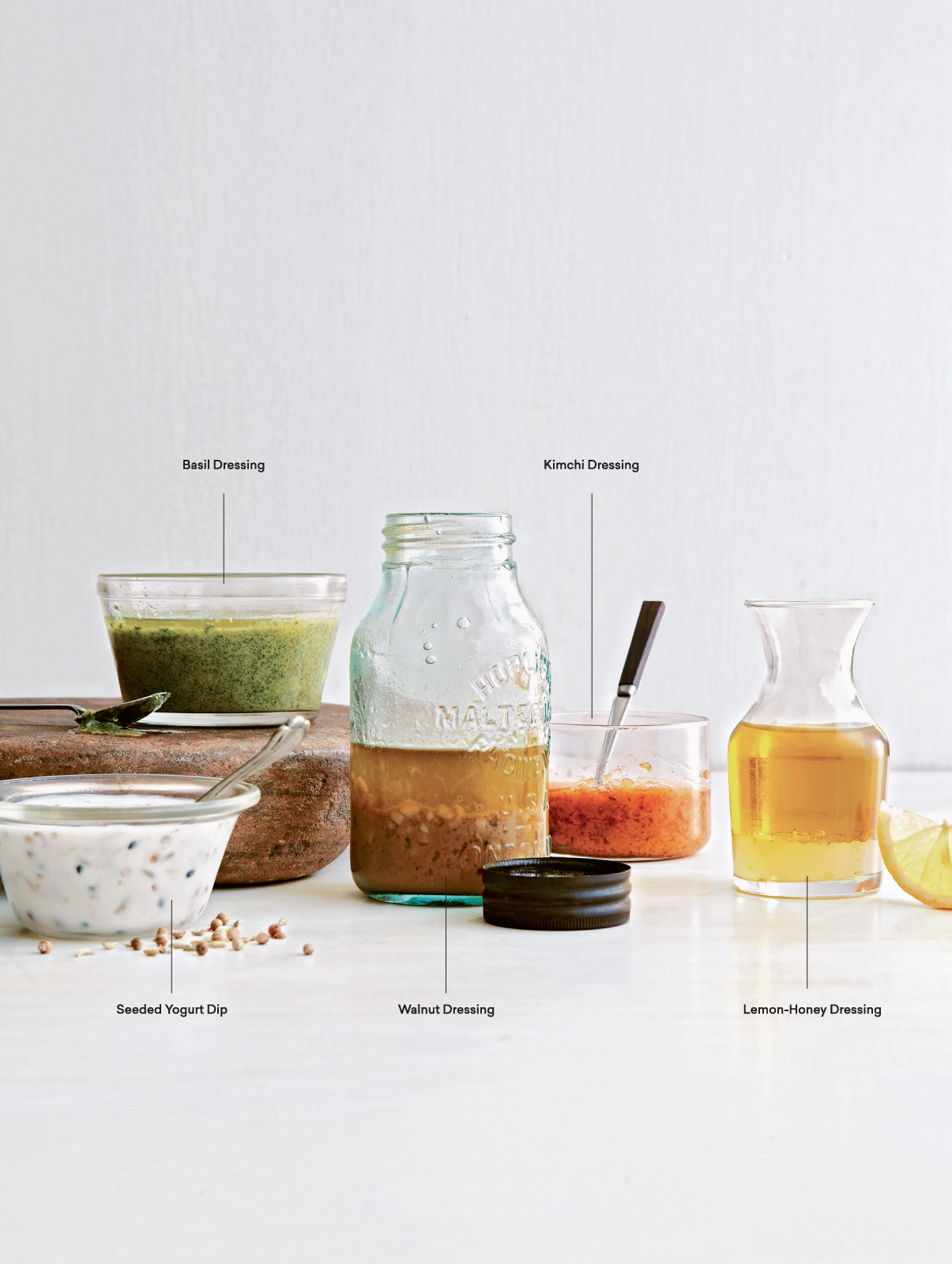 Experiment with Dressing A good dressing combines acid (like lemon juice or vinegar) with a smooth, rich vehicle (like oil or mayonnaise) to balance the sharpness and help to coat the vegetables.
Experiment with Dressing A good dressing combines acid (like lemon juice or vinegar) with a smooth, rich vehicle (like oil or mayonnaise) to balance the sharpness and help to coat the vegetables.  Experiment with Dressing A good dressing combines acid (like lemon juice or vinegar) with a smooth, rich vehicle (like oil or mayonnaise) to balance the sharpness and help to coat the vegetables.
Experiment with Dressing A good dressing combines acid (like lemon juice or vinegar) with a smooth, rich vehicle (like oil or mayonnaise) to balance the sharpness and help to coat the vegetables.
My basic proportions are 1 part acid to 3 parts oil, but this can change depending on the sharpness of the vinegar, the ingredients I am dressing, and even my mood. This book contains a whole library of dressings for you to draw upon. Mix and match them with any combination of vegetables or grains that appeals to you, or use them as dips, sandwich condiments, and marinades. Pay Attention to Seasoning This cannot be overstated. Use care and take your timetaste, taste, and taste again for the right amount of salt and freshly ground black pepper. Balance is key: sweetness against salt, richness with acidity.
Next page

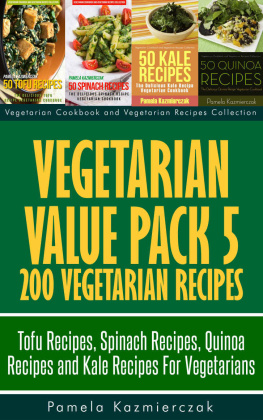



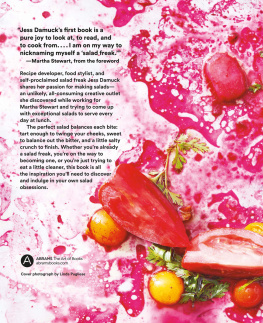
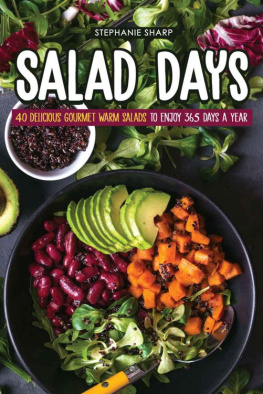
![Schurman - The Everything Salad Book: Includes Raspberry-Cranberry Spinich Salad, Sweet Spring Baby Salad, Dijon Apricot Chicken Salad, Mediterranean Tomato Salad, Sesame! EhWd]e Coleslaw](/uploads/posts/book/94669/thumbs/schurman-the-everything-salad-book-includes.jpg)
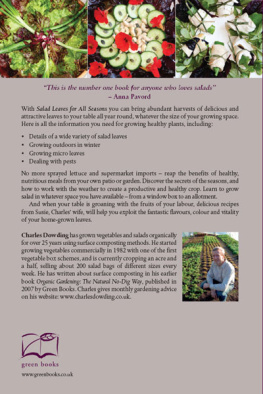
 Saladish A Crunchier, Grainier, Herbier, Heartier, Tastier Way with Vegetables Ilene Rosen with Donna Gelb Photographs by Joseph De Leo illustrations by emma dibben
Saladish A Crunchier, Grainier, Herbier, Heartier, Tastier Way with Vegetables Ilene Rosen with Donna Gelb Photographs by Joseph De Leo illustrations by emma dibben  Artisan | New York For my mother, and for the memory of my father. For Isabel and for Hannah. Contents Introduction All the food I really love to make and eat is saladish. The base might be leafy greens or nutty farro. The salad may be fluffy or crisp, spicy or sweet, tangy or creamysome of my favorites are a combination of all these (and more!). Healthy, satisfying, and simple to prepare, salads can be made from anything and everythingand a salad makes a meal.
Artisan | New York For my mother, and for the memory of my father. For Isabel and for Hannah. Contents Introduction All the food I really love to make and eat is saladish. The base might be leafy greens or nutty farro. The salad may be fluffy or crisp, spicy or sweet, tangy or creamysome of my favorites are a combination of all these (and more!). Healthy, satisfying, and simple to prepare, salads can be made from anything and everythingand a salad makes a meal. Experiment with Dressing A good dressing combines acid (like lemon juice or vinegar) with a smooth, rich vehicle (like oil or mayonnaise) to balance the sharpness and help to coat the vegetables.
Experiment with Dressing A good dressing combines acid (like lemon juice or vinegar) with a smooth, rich vehicle (like oil or mayonnaise) to balance the sharpness and help to coat the vegetables.